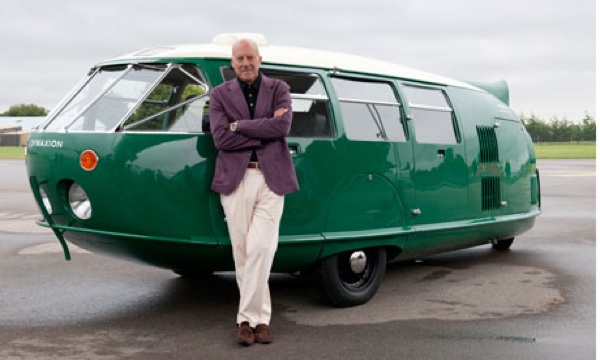 |
| http://www.bfi.org/about-bucky/buckys-big-ideas |
Fuller did not limit himself to one field but worked as a 'comprehensive anticipatory design scientist' to solve global problems surrounding housing, shelter, transportation, education, energy, ecological destruction, and poverty.
Throughout the course of his life Fuller held 28 patents, authored 28 books, received 47 honorary degrees. And while his most well known artifact, the geodesic dome, has been produced over 300,000 times worldwide ..
Fuller's true impact on the world today can be found in his continued influence upon generations of designers, architects, scientists and artists working to create a more sustainable planet.
http://www.bfi.org/about-bucky
http://boingboing.net/2010/10/07/bucky-fullers-dymaxi.html

In 1933, Buckminster Fuller designed the Dymaxion car, a concept vehicle that could hold 11 passengers and had a fuel efficiency of 30+ miles per gallon. Three prototypes were built, but the only survivor is in the National Automobile Museum in Reno, Nevada. Recently though, renowned UK architect Norman Foster, one of Fuller's colleagues late in his life, commissioned construction of his own Dymaxion car. Right now, it's on exhibition at the Bucky Fuller & Spaceship Earth exhibition in Madrin, Spain. From The Guardian:
- I watched Foster's Dymaxion No 4 being made in East Sussex, at racing car restorers Crosthwaite & Gardiner. Foster was introduced to this haven of automotive engineering by David Nelson, one of his partners and the co-designer of the elegant McLaren Technology Centre in Woking. It was a marriage made in heaven. "As a child," says Foster, ""I lived in a fantasy world inhabited by these cars and their legendary drivers: Bernd Rosemeyer in the rear-engined Auto Union and Rudolf Caracciola in the Mercedes-Benz, racing at Nurburgring, Tripoli and Monaco."
- The C&G team had many questions. Restorer Phil King went off to Reno to take 2,000 photographs of No 2, which was in a sorry state. Eventually, with the promise that Foster would create a new interior for the car, No 2 was shipped to Sussex. Meanwhile, Foster's team worked through the Buckminster Fuller Archive at Stanford University, while King and co improvised when clues were unforthcoming. The Dymaxion, says King, "was unlike anything I'd seen before: you almost have to forget everything you've learnt about car engineering to understand how it works."
- Why? Well, as with the originals, No 4's shell comprises an ash frame sheathed in hand-beaten aluminium. This sits on the chassis of an old 1934 Ford Tudor Sedan, but front to back, so the back wheels of the Ford form the front wheels of the Dymaxion. Much of the detailing echoes Zeppelin design, while its V8 Ford engine is a mounted at the rear, under a long tailfin designed to both cool the engine and increase stability. It is steered by the single rear wheel, which acts like a boat's rudder.
DYMAXION BLIMPS CAN BE 'INVENTED' TO TAKE BUCKY INTO OUR 21CENTURY AND THEN THE FEDERAL RESERVE'S DIGITAL DUST WOULD NOT BE NECESSARY TO DESTROY THE IDEA OF 'SUSTAINABLE FUTURE'

No comments:
Post a Comment